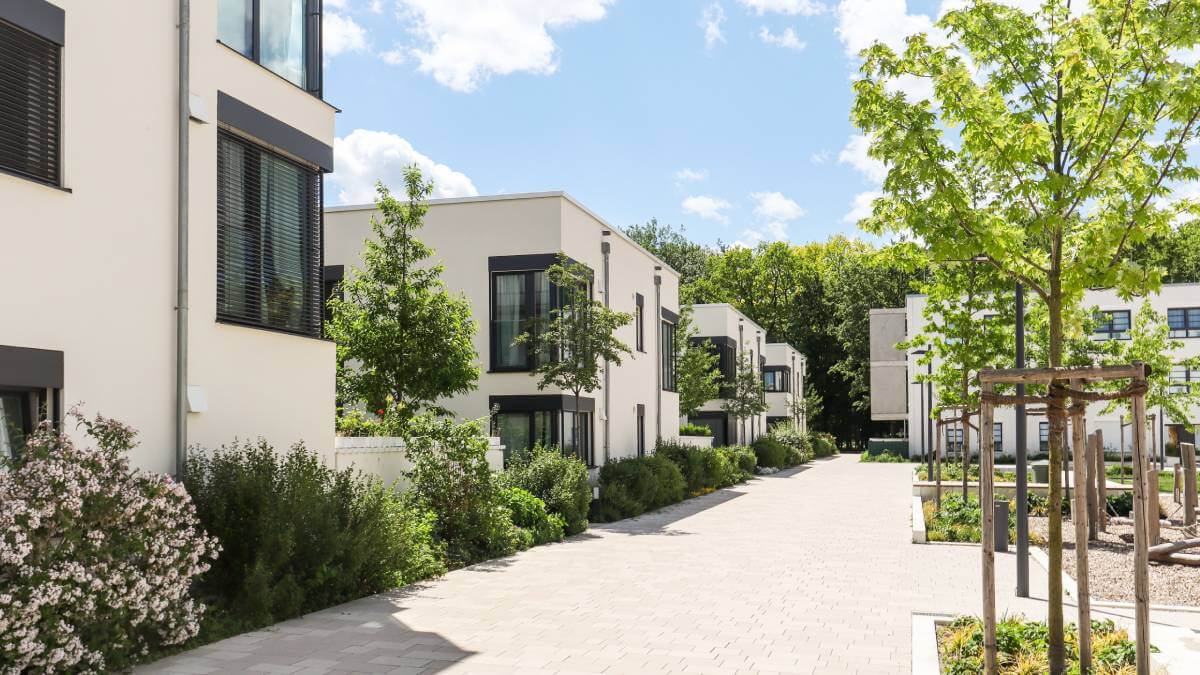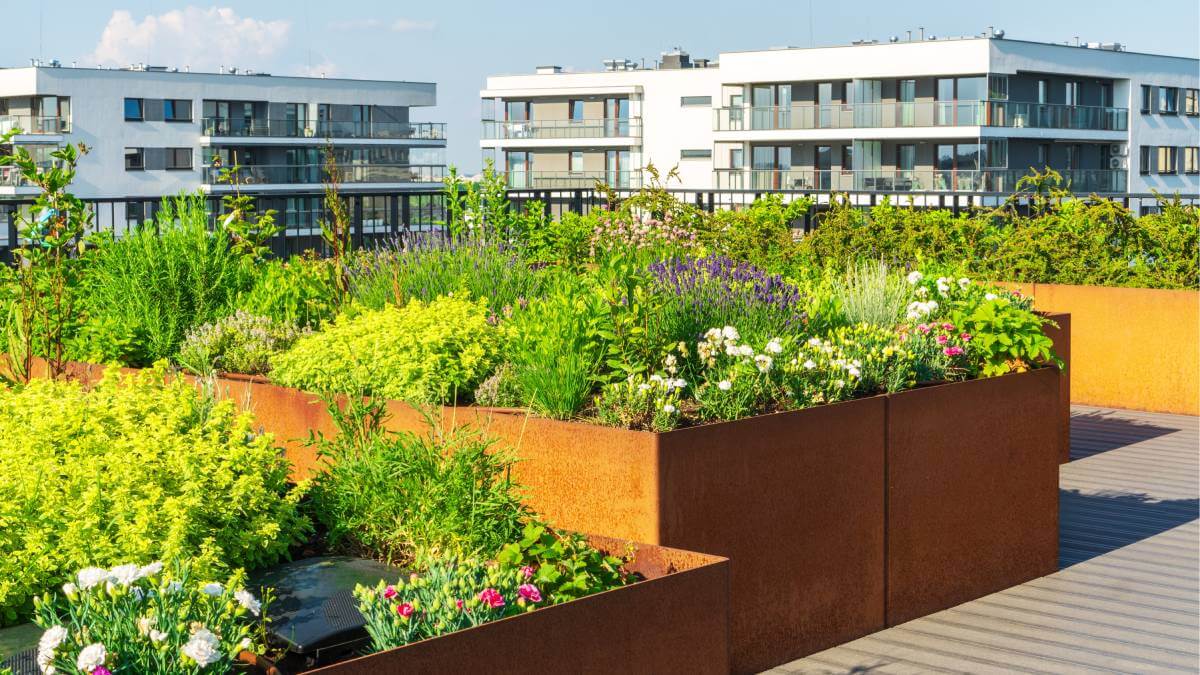Sustainability is one of those words that gets used in almost every industry – from the food we eat to the clothes we wear – but in construction, it’s more than just a passing trend. The reality is that construction is one of the largest contributors to climate change, responsible for significant greenhouse gas emissions, generating huge amounts of waste, and consuming vast natural resources at a rapid pace.
This is where sustainable architecture comes in. Modern designers are no longer focused solely on balancing form and function; they’re also ensuring that every stage of a building’s life – from planning and construction to operation and eventual reuse – is as environmentally responsible as possible.
In this article, we’ll explore the real meaning behind sustainable architecture, why it’s so important, and the practical steps you can take to incorporate it into your next project.
Achieving Sustainable Architecture In The Modern World
With over 20 years of experience, we’ve seen firsthand how environmental awareness is shaping building projects. Sustainability is no longer a “nice-to-have” but a key consideration that influences every decision from concept to the final handover.
At Amico Design, we tailor every project to the client’s specific needs, guiding them through RIBA stages 1–7 with a close eye on environmental regulations and sustainable design principles. This means we’re involved at every step – from initial feasibility studies and planning applications to building regulation approval – ensuring sustainable opportunities are maximised.
This guide brings together our expertise to break down what it truly means to create a sustainable building and how you can integrate green principles into your next development.
Here’s what we’ll cover:
- What is sustainable architecture?
- Why is sustainability important in architecture?
- How to achieve sustainability in architecture
- Examples of sustainable architecture

What Is Sustainable Architecture?
The United Nations defines sustainability as: “Meeting the needs of the present without compromising the ability of future generations to meet their own needs.”
In architecture, sustainability refers to the creation of buildings that meet the needs of people today without compromising the environment for future generations. Also known as green architecture, this approach considers a building’s entire life cycle:
- Design stage: Making responsible choices about layout, orientation, and materials.
- Construction stage: Reducing waste, using energy-efficient methods, and sourcing local materials to cut transport emissions.
- Operation stage: Ensuring the building uses as little energy and water as possible, while maintaining comfort and functionality.
- End of life: Designing for adaptability, deconstruction, and material reuse rather than demolition and landfill.
A truly sustainable building conserves resources, generates minimal waste, and operates efficiently while maintaining comfort and aesthetics.
It also considers the environmental value of the site itself. For example, if a developer has a plot of land with 100 mature trees, removing them will have a significant impact on local biodiversity. Sustainable thinking asks: Can the design be adapted to protect this natural asset?
With so many interconnected factors, having experienced guidance is key. If you’re looking for experienced architects in Leicester or the surrounding areas, our reputable team can help you consider questions you may not have even thought to ask.

Why Is Sustainability Important In Architecture?
The world’s population is growing, and so is the demand for housing, commercial spaces, and infrastructure. But while the number of buildings increases, the size of the earth remains the same. This makes sustainable architecture more important than ever.
Here are some of the main reasons it matters – not just for the environment, but for people, communities, and businesses:
- Protecting finite resources: Sustainable architecture prioritises renewable and recyclable materials. By reducing our reliance on finite resources, such as certain metals or fossil fuels, we preserve them for future generations and minimise the environmental costs associated with extraction and manufacturing.
- Supporting biodiversity: Thoughtfully designed green spaces, wildflower gardens, and living roofs provide habitats for pollinators, birds, and other wildlife. This helps counteract the State of Nature finding that wildlife abundance has dropped by an average of 19% since the 1970s.
- Improving air and water quality: Sustainable buildings often include advanced ventilation systems and effective water management. Cleaner air improves occupant health, while sustainable drainage and greywater systems prevent pollutants from entering local ecosystems.
- Lowering greenhouse gas emissions: Energy-efficient designs reduce reliance on fossil fuel-based energy, directly cutting carbon emissions and helping combat climate change.
- Enhancing occupant wellbeing: Natural lighting, healthy indoor air, and connection to outdoor spaces all contribute to better mental and physical health for those who use the building.
- Economic savings: While sustainable systems sometimes require higher upfront investment, they can reduce operational costs over the building’s lifetime through lower energy bills, reduced water usage, and less maintenance.

How To Achieve Sustainability In Architecture
Achieving a truly sustainable building requires a combination of design foresight, material choice, and technology. Our specialists can work with you to integrate these features and suggest additional approaches based on your site and needs.
- Material selection: Opt for eco-friendly, low-impact materials such as reclaimed wood, bamboo, or recycled plastic. Cellulose insulation, made from recycled paper products, is an effective and sustainable alternative to conventional insulation. Sourcing materials locally not only supports the economy but also reduces transport emissions.
- Energy-efficient systems: Solar panels, wind turbines, and heat pumps can be integrated into new builds or retrofitted into existing structures. Battery storage allows energy to be saved for later use, reducing reliance on the grid during peak times.
- Cool roofs: Reflective coatings or green roofs help maintain cooler internal temperatures, reducing the need for air conditioning. Green roofs also absorb rainwater, improve insulation, and create natural habitats for wildlife.
- Water management systems: Rainwater harvesting systems store water for irrigation and toilet flushing, while greywater recycling allows for safe reuse of water from showers and sinks.
- Smart technology: Automated lighting, heating, and cooling systems ensure energy is only used when needed, optimising efficiency without compromising comfort.
- Biophilic design: Integrating natural elements like living walls, internal gardens, and daylight-rich spaces can improve well-being while reducing reliance on artificial lighting and air conditioning.
- Adaptive reuse: Instead of demolishing old buildings, consider adapting them for new purposes. Retrofitting not only preserves history but also reduces the waste and emissions associated with new construction.

Examples Of Sustainable Architecture
Here are four UK-based examples of architecture that have sustainability at the heart of their design:
One Angel Square, Manchester
The Co-operative Group’s headquarters showcases how large commercial buildings can achieve exceptional environmental performance. This 72,000 square metre office building features a double-skin facade that provides natural ventilation, integrated photovoltaic panels, rainwater recycling systems, and innovative waste management facilities. The building achieved BREEAM Outstanding status and has reduced energy consumption by 50% compared to conventional office buildings of similar size.
The Enterprise Centre, University of East Anglia
The Enterprise Centre at the University of East Anglia is one of the UK’s most sustainable academic buildings, achieving both Passivhaus certification and BREEAM Outstanding. Designed for a 100-year lifespan, it uses locally sourced and recycled materials, including Norfolk straw thatch panels, Thetford Forest timber, and reclaimed wood. A low-carbon concrete mix reduced foundation emissions by 62%, while triple glazing, super-insulation, and MVHR ensure exceptional energy efficiency. Generating nearly a third of its electricity from rooftop solar panels, the building provides lecture theatres, business incubation space, and collaborative work areas.
BedZED, London
Completed in 2002, BedZED is one of the UK’s most ambitious sustainable housing projects. It features 82 carbon-neutral homes featuring super-insulation, passive solar design, and renewable energy systems. The development includes workspace, community facilities, and a sustainable transport network. What makes BedZED a particularly great example is its holistic approach – residents are encouraged to adopt sustainable lifestyles through shared facilities, local food production, and car-free living options.
Passivhaus Premium Home, Cotswolds
Featured on Channel 4’s Grand Designs, this property is the UK’s first certified Passivhaus Premium home. Designed for ultra-efficiency, it achieves an impressive airtightness of just 0.415 air changes per hour, well below the 0.6 threshold, even featuring a clever airtight cat flap. Its renewable energy setup is what truly sets it apart: the home generates four times the energy it consumes through a bespoke solar-fabric roof and acts like a miniature power station. It has negative running costs, and all surplus energy is exported to the grid. Learn more in the video below:
Shaping The Future Of Design
Sustainable architecture goes beyond good looks – it’s about tackling today’s environmental challenges while creating spaces that are healthier and more efficient to live and work in. From the materials you choose to the way you manage energy and even how the building interacts with nature, each decision shapes its impact on the planet for years to come.
If you’re planning a project and want to explore how your build can be made more sustainable, our team is here to help. Whether you’re looking for architects in Northampton or nearby areas, we’ll work with you to design a building that’s not only functional and beautiful but also environmentally responsible.
Contact Amico Design today to discuss how we can bring your sustainable vision to life.
